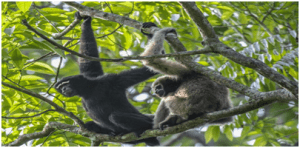1. PM-PRANAM (PM PROGRAMME FOR RESTORATION, AWARENESS, NOURISHMENT AND AMELIORATION OF MOTHER EARTH) SCHEME
TAG: SCHEMES AND INITIATIVES
THE CONTEXT: Union Budget 2023–24 launched the PM-PRANAM to promote the balanced use of chemical and alternative fertilisers, generating awareness of Regenerative Agriculture (RA). In this context, there is debate over whether the scheme will reduce the fertiliser subsidies and boost the Regenerative Agriculture (RA).
EXPLANATION:
- Regenerative Agriculture is an outcome-based food production system that nurtures and restores soil health, protects the climate and water resources and biodiversity, and enhances farms’ productivity and profitability.
- It is worth noting that the subsidy burden on chemical fertilisers is about ₹2.25-lakh crore for FY 2022-23, which is 39 per cent higher than FY 2021-22’s figure (₹1.62-lakh crore).
- The PRANAM scheme may encounter a few challenges amid some opportunities.
- Fertiliser consumption shows that nitrogenous fertiliser consumption, especially urea, has not declined from 2012-13 until 2021-22 (P). However, the subsidy bill has increased significantly. So, promoting PRANAM will help the government reduce subsidy bills and fiscal deficits if it picks up.
- Nevertheless, the efficacy of alternative fertilisers to enhance crop yield or productivity remains a concern. Thus, a gradual phase-out of subsidies on chemical fertilisers can stimulate alternative or bio-fertiliser adoption.
- PRANAM can increase its economies of scale and help the extant distribution network stock alternative fertilisers. However, the margin on bio-fertiliser sales should be worked out to incentivise sales and distribution networks.
PM-PRANAM (PM Programme for Restoration, Awareness, Nourishment and Amelioration of Mother earth) SCHEME
- The scheme’s goal is to encourage states and union territories to employ alternative fertilizers and balance their chemical fertilizer consumption.
- The scheme seeks to minimize the subsidy burden on chemical fertilizers, which is projected to increase by 39% in 2022-2023, from Rs.1.62 lakh crore to Rs.2.25 lakh crore.
- It seeks to discourage the use of synthetic or chemical fertilizers and encourage sustainable agricultural practices.
- The government will evaluate the utilisation of fertilisers in terms of increase or decrease in overall consumption in a year vis-a-vis consumption over the past three years.
- The Integrated Fertilisers Management System (iFMS) is the platform envisaged to track the use of fertilisers.
How will the scheme operate?
- The scheme will not have a separate budget and will be subsidized by the savings of existing fertiliser assistance under schemes run by the Department of fertilisers.
- The scheme will use savings from subsidies to encourage states to use alternative soil nutrients and keep track of the use of fertilisers.
- 50% subsidy savings will be given as a grant to the state that saves the money, of which 70% can be used for asset creation related to the technological adoption of alternative fertilisers and alternative fertiliser production units at village, block, and district levels.
- The remaining 30% can be utilised for incentivising farmers, panchayats, farmer-producer organisations, and self-help groups that are involved in the reduction of fertiliser use and awareness generation.
How is the scheme beneficial?
- The PM PRANAM scheme will accelerate policies that not only enhance agricultural production but also safeguard the environment and health.
- According to the government, India’s consumption of fertilisers was about 40 million metric tonnes from April to mid-December 2022, with production of 32 mmt and imports of 12.8 mmt.
- The scheme is aimed at reducing the use of chemical fertilisers, especially urea. Excessive exposure to fertilisers affects human health through cancer and diseases caused by DNA damage. Fertilisers also pollute water bodies, leading to algal bloom and affecting aquatic life.
- The scheme will promote the use of other nutrients and fertilisers, including natural nutrients. This is expected to improve soil quality in the long run and increase crop yields, apart from preventing environmental damage.
2. US-INDIA RENEWABLE ENERGY TECHNOLOGY ACTION PLATFORM (RETAP)
TAG: GS 2: INTERNATIONAL RELATIONS; GS 3: ENVIRONMENT
THE CONTEXT: In a move towards a greener future, the United States Department of Energy (DOE) and India’s Ministry of New and Renewable Energy (MNRE) came together to introduce the US-India Renewable Energy Technology Action Platform (RETAP).
EXPLANATION:
- During the meeting, the delegations shared information about emerging technology developments in each country, including hydrogen, energy storage, wind, geothermal energy, and clean energy deployment programs among others.
- DOE and MNRE intend to enhance RETAP collaboration, including potentially through the creation of a RETAP Steering Committee, joint working groups and collaboration among subject matter experts.
- RETAP has been established as a result-oriented, time-bound platform with a keen focus on technology. Its primary objective is to propel the development and deployment of new and emerging renewable technologies.
- In its initial phase, RETAP is set to concentrate on green and clean hydrogen, wind energy, long-duration energy storage, and explore prospects in geothermal energy, ocean/tidal energy, and other technologies as they emerge in the future.
- The collaboration blueprint for RETAP has been outlined by DOE and MNRE and is guided by five overarching themes:
- Research & development
- Piloting & testing of innovative technologies
- Advanced training & skill development
- Policy and planning for advancing renewable energy technologies
- Investment, incubation, and outreach programs.
- DOE and MNRE intend to enhance RETAP collaboration, including potentially through the creation of a RETAP Steering Committee, joint working groups and collaboration among subject matter experts.
- It is intended to advance new and emerging renewable technologies with a view toward deployment and scaling.
SOURCE: https://pib.gov.in/PressReleasePage.aspx?PRID=1953550
3. LAKE TOBA AND UNESCO GLOBAL GEOPARK
TAG: GS 1 : GEOGRAPHY
THE CONTEXT: Google Doodle celebrates Lake Toba, known as Danau Toba, located on the Indonesian island of Sumatra. Lake Toba was designated as UNESCO Global Geopark on August 31, 2020.
EXPLANATION:
Lake Toba
- Lake Toba is a large natural lake in North Sumatra, Indonesia, occupying the caldera of a super volcano with a surface elevation of about 900 metres (2,953 ft).
- It is the largest lake in Indonesia and the largest volcanic lake in the world and one of the deepest lakes in the world.
- Toba Caldera is one of twenty geoparks in Indonesia,and was recognised in July 2020 as one of the UNESCO Global Geoparks. It was formed as a result of a massive volcanic eruption from Toba Caldera thousands of years ago.
- The collapse of the volcano’s magma chamber formed the island of Samosir, which is a popular tourist destination and home to various Indigenous ethnic tribes.
- In addition to celebrating Lake Toba, it’s essential to acknowledge the Indigenous Batak Toba people, the lake’s native inhabitants.
- Their traditional villages, local markets, and distinctive houses attract visitors from around the world. Traditional dances like the Tor-Tor and authentic wood carvings are common in these villages.

UNESCO Global Geoparks
- UNESCO Global Geoparks are single, unified geographical areas where sites and landscapes of international geological significance are managed with a holistic concept of protection, education and sustainable development.
- UNESCO Global Geoparks are:
- Managed by a nationally recognised body such as a local authority or Geopark Management Group
- Visible to the public in their promotion of geology, sustainable development and education
- Their bottom-up approach of combining conservation with sustainable development while involving local communities has become increasingly popular.
- At present, there are 169 UNESCO Global Geoparks in 44 countries.
4. HOLLONGAPAR GIBBON SANCTUARY
TAG: GS 3: ECOLOGY AND ENVIRONMENT
THE CONTEXT: Recently, Experts recommended to reroute the Railway track through the Assam Gibbon Sanctuary.
EXPLANATION:
- Primatologists have suggested to reroute a 1.65-km-long railway track that has divided an eastern Assam sanctuary dedicated to the western hoolock gibbon (Hoolock hoolock) into two unequal parts.

Western hoolock gibbons in Assam’s Hoollongapar Gibbon Sanctuary.
Hoolock Gibbon:
- It is the only ape found in India.
- It is one of the 20 species found worldwide inhabiting tropical and subtropical forests in Southeast Asia.
- They are found in forested areas of Northeast India, Bangladesh, Myanmar, and Southern China.
- It is the smallest and fastest of all apes.
- They have become endangered due to habitat loss and fragmentation.
- The species is listed on Schedule 1 of the Indian (Wildlife) Protection Act 1972.
- It is categorised into Western Hoolock Gibbon and Eastern Hoolock Gibbon.
- Western Hoolock Gibbon is listed as Endangered and Eastern Hoolock gibbon as Vulnerable on the IUCN Red List.
Hollongapar Gibbon Sanctuary:
- The Hoollongapar Gibbon Sanctuary was formerly known as the Gibbon Wildlife Sanctuary or Hollongapar Reserve Forest.
- It is an isolated protected area of evergreen forest located in the Jorhat district of Assam.
- The upper canopy of the forest is dominated by the Hollong tree, while the Nahar dominates the middle canopy. The lower canopy consists of evergreen shrubs and herbs.
- The sanctuary has a rich biodiversity and is home to the only apes in India, the western Hoolock, as well as the only nocturnal primate found in the northeast Indian states, the Bengal slow loris.
- It is home to Stump-tailed macaque, northern pig-tailed macaque, eastern Assamese macaque, rhesus macaque, and capped langur etc.
5. SUPERMOON AND BLUE MOON
TAG: GS 3: SCIENCE AND TECHNOLOGY
THE CONTEXT: Supermoon, a very rare event was seen on 31st august, 2023. It is one of the largest and brightest moons of 2023. It was the second supermoon of August. The first one appeared on August 1.
Explanation:

WHAT IS SUPERMOON?
- A supermoon occurs when the Moon’s orbit is closest (perigee) to Earth at the same time the Moon is full.
- Its closest point is the perigee, which is an average distance of about 226,000 miles (363,300 kilometers) from Earth.
- When a full moon appears at perigee it is slightly brighter and larger than a regular full moon – and that’s where we get a “supermoon.
- A supermoon occurs every two and a half years on average.
- The supermoon casts 30% more light on Earth compared to the dimmest full moon.

WHAT IS BLUE MOON?
- A Blue Moon has nothing to do with the colour of the Moon.
- Normally blue moons occurs about every two or three years.
- Blue Moon can be described as the second full Moon in any calendar month with two full moons.
- As August 2023 ended up with two full moons, so by this definition second moon was blue moon.
Note:
- According to NASA: About 25 percent of all full moons are supermoons, but only 3 percent of full moons are blue moons.


